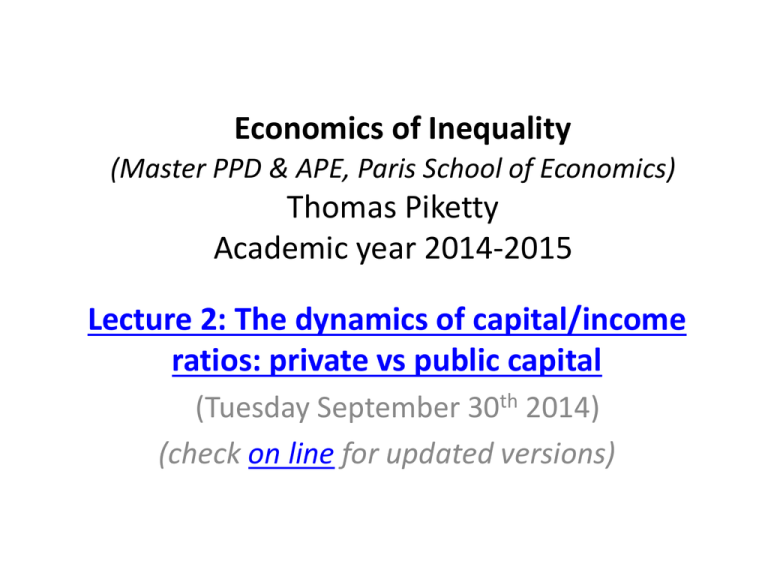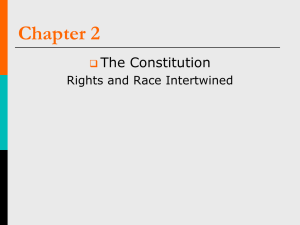(Master PPD & APE, Paris School of Economics) Thomas Piketty
advertisement

Economics of Inequality (Master PPD & APE, Paris School of Economics) Thomas Piketty Academic year 2014-2015 Lecture 2: The dynamics of capital/income ratios: private vs public capital (Tuesday September 30th 2014) (check on line for updated versions) The very long-run: Britain and France 1700-2010 • Long tradition of national wealth estimates in Britain and France in the 18th-19th centuries: Britain: Petty, King, Giffen, etc.; France: Vauban, Lavoisier, Colson, etc. • National balance sheets: estimates of all assets and liabilities held by residents of a country (and by the government) (« Bilans patrimoniaux par pays ») • These estimates are not sufficientely precise to study short-run fluctuations; but they are fine to study broad orders of magnitudes and long-run evolutions • See « Capital is Back – Wealth-Income Ratios in Rich Countries 1700-2010 », 2013, Data Appendix, Database, for detailed bibliography and methodological issues • Longest series: Britain and France national wealth/national income ratio βn=Wn/Y over 1700-2010 • National wealth Wn = Private wealth W + Public (or government) wealth Wg • Wn = Domestic capital K + Net foreign assets NFA • Domestic capital K = agricultural land + residential housing + other domestic k (=offices, structures, machines, patents, etc. used by firms and administrations) • Two major facts: (1) huge U-shaped curve: βn≈700% over 1700-1910, down to 200-300% around 1950, up to 500600% in 2000-2010 (2) Radical change in the nature of wealth (agricultural land has been gradually replaced by housing, business and financial capital), but total value of wealth did not change much in the very long run The rise and fall of foreign assets • NFA close to 0 in 1700-1800 and 1950-2010, but very large in 1870-1910 = the height of the « first globalization » and of colonial empires • In 1910, NFA≈200% of Y in UK, ≈100% in France • These enormous net foreign assets disappeared between 1910 and 1950 and never reappeared (but large cross-border gross positions developed since 1970s-80s: « second globalization ») • 2010: Y ≈ 30 000€, Wn ≈ 180 000€ (βn≈ 6), including 90 000€ in housing and 90 000€ in other domestic k (financial assets invested in firms and govt) • 1700: assume Y ≈ 30 000€, then Wn ≈ 210 000€ (βn≈ 7), including 150 000€ in agricultural land and 60 000€ in housing and other domestic capital • 1910 (UK): assume Y ≈ 30 000€, then Wn ≈ 210 000€ (βn≈ 7), including 60 000€ in housing, 90 000€ in other domestic capital and 60 000€ in net foreign assets • With NFA as large as 100-200% Y, the net foreign capital income is very large: around 1900-1910, as large as 5% Y in France and 10% Y in Britain (average rate of return r=5%) • In effect, both countries were able to have permanent trade deficits (about 2% Y in 1870-1910) and still to have a current account surplus and to accumulate more foreign reserves; i.e. they were consuming more than they what were producing, and at the same time they were getting richer • Two conclusions: (1) it’s nice to be a owner; (2) there’s no point accumulating trade surpluses for ever Private versus public wealth • • • • National wealth Wn = Private wealth W + Public wealth Wg Private wealth = private assets – private debt Public wealth = public assets – public debt Today, in most rich countries, public wealth close to 0 (public assets ≈ public debt ≈ 100% Y), and private wealth ≈ 95-100% of national wealth • But it has not always been like this: sometime the govt owns a significant part of national wealth (20-30% in 1950s-60s in W. Europe; 80% in USSR); sometime govt wealth<0 (huge debt), so that private wealth is significantly larger than national wealth Britain: public debt and Ricardian equivalence • Britain = the country with the longest historical episodes of public debt: about 200% of Y around 18101820 (it took a century to reduce it below 50% by 1910, after a century of budget surpluses), and about 200% of Y again around 1950 (it was reduced faster, thanks to inflation) • Big difference with France (large inflation and/or repudiation during 1790s & World Wars 1 and 2) and Germany (the country with the largest inflation in 1910-1950, even excluding 1924) • Britain always paid back its debt (limited inflation, except 1950-1980); this is why it took so long to reduce debt, especially during 19c • Q.: What is the impact of public debt on capital accumulation? • A.: It depends on how the private saving responds to public deficit • National saving Sn = private saving S + public saving Sg (<0 if public deficit) • Suppose dSg<0 (public deficit↑) • If dS=0 (no private saving response), then dSn<0 → decline in national wealth Wn : in effect public deficits absorb part of private saving (=« crowding out ») • But if dS>0, i.e. private saving increase in order to absorb the extra deficit, then crowding-out might be limited • In case dS=-dSg, then dSn=0: national saving and national wealth are unaffected by public deficit • = apparently what happened in UK 1810-1830: huge public debt, but no decline in private investment; extra private saving by British wealth holders, so that we observe a rise in private wealth, and no decline in national wealth = what Ricardo observes in 1817 • Key question: why was there no crowding out? • Barro 1974: in a representative agent model, rational agents should anticipate that they will pay more taxes in the future if today’s public deficit increase, so they save more in order to make reserves (for themselves or their successors) so as to pay these taxes in the future → the timing of taxes is irrelevant, « debt neutrality » (see also Barro 1987, Clark 2001) • Pb: it is unclear whether the representative agent model makes sense to study these issues; in 19c Britain, the agents holding public debt (=top 1% or top 10% wealth holders) are not the same as those paying taxes (=the entire population) • Public debt always involves large transfers between income groups: for high wealth agents, it is better to lend money than to pay taxes… as long as the debt is paid back = big difference between 19c and 20c; will 21c be more like 19c, i.e. debt will be paid back? • Whether the Ricardian equivalence holds depends on the prosperity of private savers, the rate of return that they are being offered, the ability of the govt to convince them that they will be paid back; in 19c UK, r was high, and govt highly credible France: a mixed economy in 1950-1980 • Historically, high public debt in France was always inflated away (more difficult with €) • In 1950, public debt<30% Y, and public assets >120% Y (public buildings + nationalized firms), so that net public wealth close to 100% Y; given that private wealth was close to 200% Y at that time, this means that in effect the govt owned about 1/3 of national wealth (and over 2/3 of large companies) • Same pattern in Germany 1950 (and Britain 1970) = the postwar mixed economy • Rise in public debt + privatization of public assets played a big role in rise of private wealth since 1980 (see next lecture) Capital in Germany • Same general pattern as in Britain and France • Except that NFA smaller in Germany in 18701910 (no colonial empire, late industrialization) • Except that the level of βn is lower in Germany during 1950-2010 period: lower real estate prices, lower stock market prices (stakeholder capitalism?) • Except that NFA has been rising a lot in 1990s2000s Capital in America • Very different historical pattern than in Europe • Rising βn during 19c, almost stable in 20c • Level of βn generally smaller than in Europe, particularly in 19c • Two factors: less time to accumulate capital; lower land price (more land in volume, but less land in value) • NFA always close to 0 in US; but <0 in Canada Capital and slavery in the US • In the US 1770-1865, market value of slaves ≈ 150% of Y ≈ as much as agricultural land • In Southern US, slaves ≈ 300% of Y, so that total private wealth (incl.slaves) = as large as in Europe • Huge historical literature on US slavery system: Fogel, etc. (see Data Appendix) • See also recent research on compensation to slave owners after the abolition of slavery in Britain 1833 (see UCL project) and France (Haiti debt 1825) (see also Graeber, Debt – The first 5000 years) On the value of human capital • Extreme case: if a tiny fraction owns the rest of the population, then the value of slaves (=human capital) can be much larger than nonhuman capital • Simple computation: assume marginal products of capital and labor are such as capital share = α (= r β) and labor share = 1-α (Cobb-Douglas production function: Y=F(K,L)=KαL1-α); if future labor income flows are capitalized at the same rate r, then the value of human capital should be = (1-α)/r (more on this: see lectures 3-4) • If α=30%, 1-α=70%, r=5%, then market value of (non-human) capital = α/r = 600%, and market value of human capital (slaves) = 1400%; total capital = 2000% (=1/r) • I.e. the market value of human k has always been higher than the market value of non-human k, simply because labor share >50% • But outside slave societies, it really does not make much sense to compute a market value of human capital: in modern legal systems, one cannot sell one’s labor force on a permanent basis









